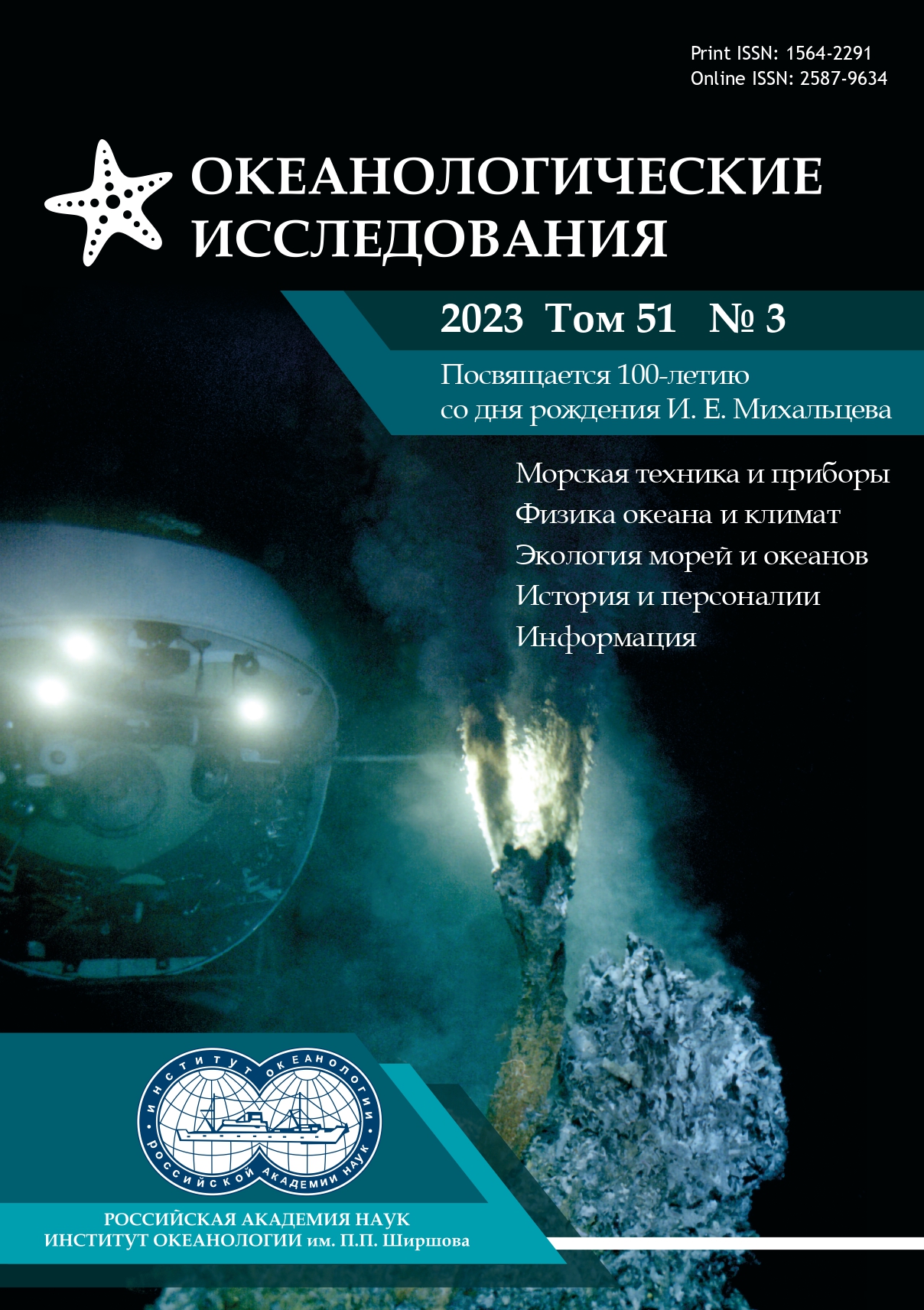ТЕКУЩИЕ ТРЕНДЫ ПРИПОВЕРХНОСТНОЙ ТЕМПЕРАТУРЫ ВОЗДУХА В АНТАРКТИДЕ ПО ДАННЫМ РЕАНАЛИЗА И НАЗЕМНЫХ СТАНЦИЙ
Аннотация
В этом исследовании по данным наземных станций в Антарктике были построены оценки трендов приповерхностной температуры воздуха за период с 1980 по 2022 годы. Анализ наземных данных подтвердил преобладающие тенденции к потеплению на континенте: положительные тренды температуры были выявлены в рассмотренных данных 11 станций из 18. Тренды среднегодовой температуры воздуха достигают значений в 0.40 °C/декаду, при этом наиболее значительное потепление происходит на станциях, расположенных на Антарктическом полуострове, в Западной Антарктике и во внутриконтинентальной части Антарктики. В прибрежных районах Восточной Антарктики были обнаружены относительно слабые переменные по знаку температурные тренды. В годовом ходе весенний сезон выделяется наиболее устойчивыми по континенту положительными трендами температуры. Сравнение текущих значений трендов температуры с их более ранними оценками указывает на ускорение потепления в последние годы на большинстве антарктических станций. В работе были проанализированы четыре часто используемых набора данных реанализа – ERA5, JRA55, MERRA2 и CFSR с целью оценить их способность по точному воспроизведению трендов температуры наблюдаемых в натурных данных. Среди этих четырех наборов данных температурные тренды, полученные с помощью ERA5, показали наилучшее соответствие результатам измерений на станциях. Однако даже в ERA5 неопределенность в оценках трендов оказалась сравнимой с величиной изменчивости трендов между станциями. Это указывает на ограниченные возможности имеющихся данных реанализа для адекватной характеристики пространственных особенностей трендов температуры по всему континенту.
Литература
- Amesbury J. M., Roland T. P., Royles J., Hodgson D. A., Convey P., Griffiths H., Charman D. J. Widespread biological response to rapid warming on the Antarctic Peninsula // Current Biology. 2017. Vol. 27. P. 1616–1622.
- Bintanja R., van Oldenborgh G. J., Drijfhout S. S., Wouters B., Katsman C. A. Important role for ocean warming and increased ice-shelf melt in Antarctic sea-ice expansion // Nature Geoscience. 2013. Vol. 6 (5). P. 376–379.
- Bozkurt D., Bromwich D. H., Carrasco J., Hines K. M., Maureira J. C., Rondanelli R. Recent near-surface temperature trends in the Antarctic Peninsula from observed, reanalysis and regional climate model data // Advances in Atmospheric Sciences. 2020. Vol. 37. P. 477–493.
- Bradley A., Bett D., Williams C. R., Arthern R., Holland P., De Rydt J. (How) can we attribute West Antarctic ice mass loss to climate change? // Copernicus Meetings. No. EGU23-8309. 2023. Feb. 20.
- Bromwich D. H., Nicolas J. P., Monaghan A. J., Lazzara M. A., Keller L. M., Weidner G. A., Wilson A. B. Correction: Corrigendum: Central West Antarctica among the most rapidly warming regions on Earth // Nature Geoscience. 2013. Vol. 6. P. 139–145.
- Cannone N., Malfasi F., Favero-Longo S. E., Convey P., Guglielmin M. Acceleration of climate warming and plant dynamics in Antarctica // Current Biology. 2022. Vol. 32 (7). P. 1599–1606.
- Carrasco J. F. Decadal changes in the near-surface air temperature in the Western side of the Antarctic Peninsula // Atmospheric and Climate Sciences. 2013. Vol. 3. P. 33653.
- Carter J., A. Leeson, A. Orr, C. Kittel and J. M. van Wessem Variability in Antarctic surface climatology across regional climate models and reanalysis datasets // The Cryosphere. 2022. Vol. 16 (9). 3815–3841.
- Clem K. R., Fogt R. L., Turner J., Lintner B. R., Marshall G. L., Miller J. R., Renwick J. A. Record warming at the South Pole during the past three decades // Nature Climate Change. 2020. Vol. 10. P. 762–770.
- Cook A. J., Holland P. R., Meredith M. P., Murray T., Luckman A., Vaughan D. G. Ocean forcing of glacier retreat in the western Antarctic Peninsula // Science. 2016. Vol. 353. P. 283–286.
- Ding Q., Steig E. J. Temperature change on the Antarctic Peninsula linked to the tropical Pacific // Journal of Climate. 2013. Vol. 26 (19). P. 7570–7585.
- Eayrs C., Li X., Raphael M. N., Holland D. M. Rapid decline in Antarctic sea ice in recent years hints at future change // Nature Geoscience. 2021. Vol. 14 (7). P. 460–464.
- Gelaro R., W. McCarty W., Suárez M. J., Todling R., Molod A., Takacs L., Randles C. A., Darmenov A., Bosilovich M. G., Reichle R., Wargan K., Coy L., Cullather R., Draper C., Akella S., Buchard V., Conaty A.,da Silva A. M., Gu W., Kim G-K., Koster R., Lucchesi R., Merkova D., Nielsen J. E., Partyka G., Pawson S., Putman W., Rienecker M., Schubert S. D., Sienkiewicz M., Zhao B. The Modern-Era Retrospective Analysis for Research and Applications, Version 2 (MERRA2) // Journal of Climate. 2017. Vol. 30. P. 5419–5454.
- Gille S. T. Decadal-scale temperature trends in the southern Hemisphere Ocean // Journal of Climate. 2008. Vol. 21. P. 4749–4765.
- Guglielmin M., Dalle Fratte M., Cannone N. Permafrost warming and vegetation changes in continental Antarctica // Environmental Research Letters. 2014. Vol. 9 (4). P. 045001.
- Gonzalez S., Fortuny D. How robust are the temperature trends on the Antarctic Peninsula? // Antarctic Science. 2018. Vol. 30 (5). P. 322–328. https://doi.org/10.1017/S0954102018000251.
- González-Herrero S., Barriopedro D., Trigo R. M., Lopez-Bustins J. A., Olivia M. Climate warming amplified the 2020 record-breaking heatwave in the Antarctic Peninsula // Communications, Earth and Environment. 2020. Vol. 3. P. 122.
- Hersbach H., de Rosnay P., Bell B., Schepers D., Simmons A., Soci C., Abdalla S., Alonso-Balmaseda M., Balsamo G., Bechtold P., Berrisford P., Bidlot J.-R., de Boisséson E., Bonavita M., Browne P., Buizza R., Dahlgren P., Dee D., Dragani R., Diamantakis M., Flemming J., Ho C., Kim J.-H., Kim H.-S., Sui C.-H., Gong D.-Y. Possible influence of the Antarctic Oscillation on tropical cyclone activity in the western North Pacific // Journal of Geophysical Research. 2005. Vol. 110. D19104. https://doi.org/10.1029/2005JD005766.
- Hobbs W. R., Massom R., Stammerjohn S., Reid P., Williams G., Meier W. A. Review of recent changes in Southern Ocean sea ice, their drivers and forcings // Global and Planetary Change. 2016. Vol. 143. P. 228–250.
- Huai B., Wang Y., Ding M., Zhang J., Dong X. An assessment of recent global atmospheric reanalyses for Antarctic near surface air temperature // Atmospheric Research. 2019. Vol. 226. P. 181–191.
- Jones P. D., Lister D. H. Antarctic near-surface air temperatures compared with ERA-Interim values since 1979 // International Journal of Climatology. 2015. Vol. 35. P. 1354–1366.
- Kennicutt M. C., Chown S. L., Cassano J. J., Liggett D., Peck L. S., Massom R., Rintoul S. R., Storey J., Vaughan D. G., Wilson T. J., Allison I. A roadmap for Antarctic and Southern Ocean science for the next two decades and beyond // Antarctic Science. 2015. Vol. 27. P. 3–18.
- Kobayashi S., Ota Y., Harada Y., Ebita A., Moriya M., Onoda H., Onogi K., Kamahori H., Kobayashi C., Endo H., Miyaoka K., Takahashi K. The JRA-55 Reanalysis: General Specifications and Basic Characteristics // Journal of Meteorological Society Japan. 2015. Vol. 93. P. 5–48.
- Marshall G. J., Thompson D. W. J., van den Broeke M. R. The signature of Southern Hemisphere atmospheric circulation patterns in Antarctic precipitation // Geophysical Research Letters. 2017. Vol. 44. P. 11,580–11,589. https://doi.org/10.1002/2017GL075998.
- Medley B., Thomas E. R. Increased snowfall over the Antarctic Ice Sheet mitigated twentieth-century sea-level rise // Nature Climate Change. 2019. Vol. 9. P. 34–39.
- Menezes V. V., McDonald A. A., Schatzman C. Accelerated freshening of Antarctic bottom water over the last decade in the Southern Indian Ocean // Science Advances. 2017. Vol. 3 (1). e1601426. https://doi.org/10.1126/sciadv.1601426.
- Mokhov I. I., Parfenova M. R. Relationship of the Extent of Antarctic and Arctic Ice with Temperature Changes, 1979–2020 // Doklady Earth Science. 2012. Vol. 496. P. 66–71. https://doi.org/10.1134/S1028334X21010153.
- Nicolas J. P., Bromwich D. H. New reconstruction of Antarctic near-surface temperatures: Multidecadal trends and reliability of global reanalyses // Journal of Climate. 2011. Vol. 24 (4). P. 926–945.
- Pinkerton M. H., Boyd P. W., Deppeler S., Hayward A., Höfer J., Moreau S. Evidence for the impact of climate change on primary producers in the Southern Ocean // Frontiers in Ecology and Evolution. 2021. Vol. 9. P. 592027.
- Raphael M. N., Handcock M. S. A new record minimum for Antarctic sea ice // Nature Reviews Earth and Environment. 2022. Vol. 3. P. 215–216. https://doi.org/10.1038/s43017-022-00281-0.
- Romanova N. A., Romanov P. Yu. Antarctic wind intensification as inferred from the NCEP/NCAR reanalysis data // Journal of Oceanological Research. 2020. Vol. 48 (3). P. 96–108.
- Romanov P. Yu., Romanova N. A. Sea-level pressure trends in the Southern Ocean and Antarctica from reanalysis and in situ data // Journal of Oceanological Research. 2021. Vol. 49 (4). P. 63–85.
- Saha S., Moorthi S., Pan H. L., Wu X., Wang J., Nadiga S., Tripp P., Kistler R., Woollen J., Behringer D., Liu H. The NCEP climate forecast system reanalysis // Bulletin of the American Meteorological Society. 2010. Vol. 91 (8). P. 1015–1058.
- Saha S., Moorthi S., Wu X., Wang J., Nadiga S., Tripp P., Behringer D., Hou Y. T., Chuang H. Y., Iredell M., Ek M. The NCEP climate forecast system version 2 // Journal of Climate. 2014. Vol. 27 (6). P. 2185–2208.
- Simmons A. J., Berrishford P., Dee D. P., Hersbach H., Hirahara S., Thepaut J.-N. A reassessment of temperature variations and trends from global reanalyses and monthly surface climatological datasets // Quarterly Journal of the Royal Meteorological Society. 2017. Vol. 143. P. 101–119.
- Smith K. E., Aronson R. B., Steffel B. V., Amsler M. O., Thatje S., Singh H., Anderson J., Brothers C. J., Brown A., Ellis D. S., Havenhand J. N., James W. R., Moksnes P.-O., Randolph A. W., Sayre-McCord T., McClintock J. B. Climate change and the threat of novel marine predators in Antarctica // Ecosphere. 2017. Vol. 8 (11). e02017. 10.1002/ecs2.2017.
- Turner J., Marshall G. J., Clem K., Colwell S., Phillips T., Lu H. Antarctic temperature variability and change from station data // International Journal of Climatology. 2019. Vol. 40. P. 2986–3007. https://doi.org/10.1002/joc.6378.
- Turner J., Phillips T., Hosking J. S., Marshall G. J., Orr A. The Amundsen Sea low // International Journal of Climatology. 2013. Vol. 33. P. 1818–1829. https://doi.org/10.1002/joc.3558.
- Turner J., Lu H., White I., King J. C., Phillips T., Hosking J. S., Bracegirdle T. J., Marshall G. J., Mulvaney R., Deb P. Absence of 21st century warming on Antarctic Peninsula consistent with natural variability // Nature. 2016. Vol. 535. P. 411–415.
- Wang G., Cai W., Purich A. Trends in Southern Hemisphere wind‐driven circulation in CMIP5 models over the 21st century: Ozone recovery versus greenhouse forcing // Journal of Geophysical Research: Oceans. 2014. Vol. 119 (5). P. 2974–2986.
- Wang Y., Zhou D., Bunde A., Havlin S. Testing reanalysis data sets in Antarctica: Trends, persistence properties, and trend significance // Journal of Geophysical Research: Atmospheres. 2016. Vol. 121 (21). P. 12,839–12,855.
- Wachter P., Beck C., Philip A., Höppner K., Jacobeit J. Spatiotemporal variability of the Southern Annular Mode and its influence on Antarctic surface temperatures // Journal of Geophysical Research: Atmospheres. 2020. Vol. 125 (23). P. e2020JD033818.
- Weller G. Regional impacts of climate change in Arctic and Antarctic // Annals of Glaciology. 1998. Vol. 27. P. 543–552.
- WMO. Antarctic sea ice reaches lowest winter extent on record. [online] Available at: https://public.wmo.int/en/media/news/antarctic-sea-ice-reaches-lowest-winter-extent-record, 2003, [Accessed 2 Oct. 2023].
- Yang Y., Li Q., Song Z., Sun W., Dong W. A comparison of global surface temperature variability, extremes and warming trend using reanalysis datasets and CMST‐Interim // International Journal of Climatology. 2022. Vol. 42 (11). P. 5609–5628.
- Yu L., Zhang Z., Zhou M., Zhong S., Lenschow D., Hsu H., Wu H., Sun B. Validation of ECMWF and NCEP-NCAR reanalysis data in Antarctica // Advances in Atmospheric Sciences. 2010. Vol. 27. P. 1151–1168.
- Zhang Y., Wang Y., Hou S. Reliability of Antarctic air temperature changes from Polar WRF: A comparison with observations and MAR outputs // Atmospheric Research. 2022. Vol. 266. 105967.
- Zhu J., Xie A., Qin X., Wang Y., Xu B., Wang Y. An Assessment of ERA5 Reanalysis for Antarctic Near-Surface Air Temperature // Atmosphere. 2021. Vol. 12. P. 217.
Передача авторских прав происходит на основании лицензионного договора между Автором и Федеральным государственным бюджетным учреждением науки Институт океанологии им. П.П. Ширшова Российской академии наук (ИО РАН)












